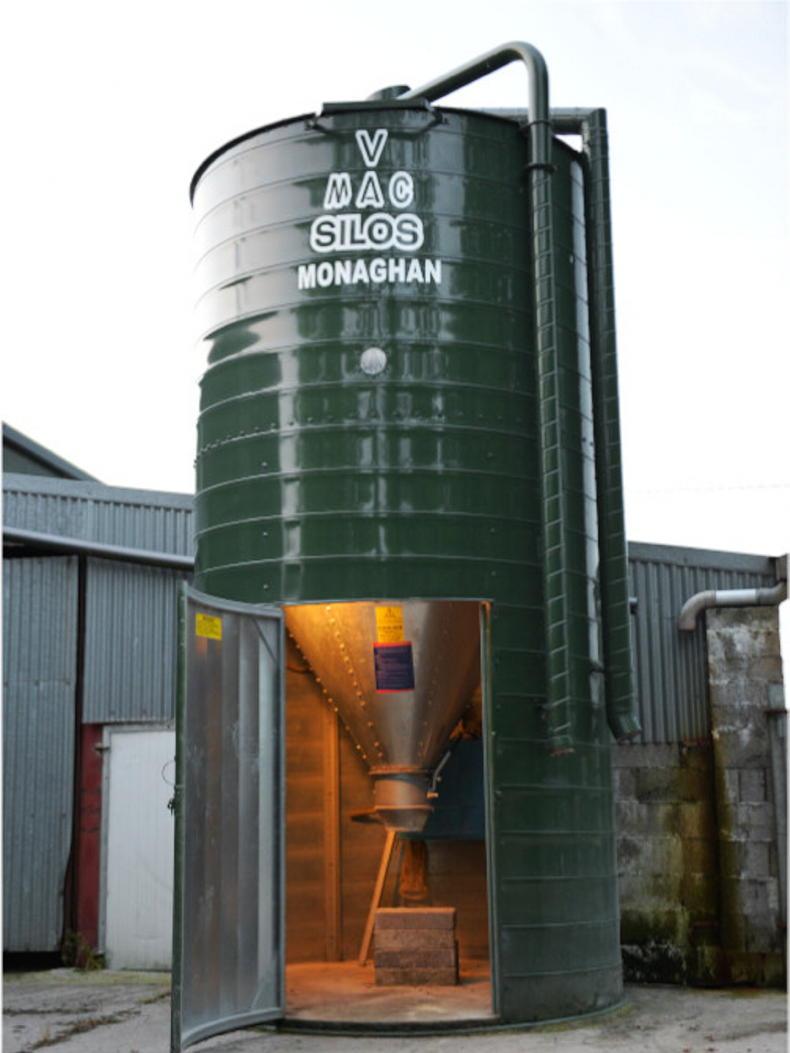In order to avoid contamination from vermin and to comply with on-farm audits (Bord Bia) all storage from concentrates should be vermin- and bird-proof.
Meal bins are the most common and cost-effective way of storing concentrates for small- to medium-sized farms. Meal bins are eligible for grant aid under TAMS III, with either a 40% or 60% grant aid available depending on eligibility.
As per the Department’s spec, meal bins/grain silos must be installed on a concrete base measuring at least 3m x 3m, 250mm thick concrete base.
Concrete cannot be produced on site and should only be purchased from an EN 206 certified manufacturer.
To order the correct type of concrete for underneath a meal bin, a farmer should request Mix B or 37N concrete and ensure it is certified as per concrete specifications S.101.
A well-known requirement of TAMS II meal bins was the requirement for bins to be painted. This rule has been carried forward into TAMS III; the likely reasoning for this is to reduce the visual impact of feed silos.
Nearly all feed silos are galvanised for longevity, although this can be a reflector of sunlight and cause glare, especially in the first few years of its life.
Most manufacturers will use powder coating of a pre-galvanised feed silo to comply with the TAMS requirements, with a range of colours available. It is best to choose the predominant sheeting colour (grey, green) of the farm buildings around the feed silo to allow it to blend in to the farmyard.
Meal bins are usually planning exempt, with a letter of exemption or full planning permission required, whichever is relevant.
Any planning permissions or letter of exemptions must be dated before the submission of an application.
In a similar way to slurry storage, costings of meal bins are not linear with size, with smaller bins generally being more expensive per m3/tonne than larger units.
For this reason, the Department has created a calculation for reference costs of meal bins: Y=108X + 3465, where Y is the cost of the meal bin and X is the metre cubed capacity of the bin.
For example, an 8t (12.7m3) meal bin reference cost can be calculated as 12.7 multiplied by 108 plus 3,465 or (12.7 x 108) + 3,465 which creates a reference cost of €4,836.60 for the 8t meal bin.
For split bins, the equation is Y=107X + 3,780. For a 16t (25.4m3) split meal bin, the reference cost can be calculated as follows; (25.4 x 107) + 3,780 = €6,497.80 of a reference cost.
Applicants should note that grant aid will be paid out on whichever is the lower amount, either the reference cost or the actual cost.
If a farmer purchases the 8t meal bin above for €4,500, they will be paid a grant rate of 40% or 60% of this figure, and not the reference cost. The submission of costs should be exclusive of VAT as grant aid will not be paid out on the VAT amount.
Can I install a meal bin in an existing shed and avoid planning permission/ a letter of exemption?
Yes, meal bins can be installed in sheds and not require planning permission or exemption, but the shed it is installed in must have planning.
Can automatic feeders be installed in a parlour using TAMS aid?
Auto-feeders were grant aided in the Dairy Equipment Scheme in TAMS I and II but were removed in TAMS III.
Are meal bucket feeders for tractors/telehandlers grant-aided?
Technically, meal buckets are not grant-aided, but they can be purchased as part of a bale slice unit with some manufacturers offering them as an optional extra. The reference cost will remain the same.
As such, all eligible applications for TAMS III are set to be approved, though when this approval will reach farmers is still unknown.
In the past, acceptance or a letter of decline generally reached farmers before the closing date for the currently open tranche (tranche two, in this case) reached farmers’ doors.
With no current closing date outlined for tranche two, farmers will still remain in limbo regarding tranche one and will likely not see much building works carried out this side of Christmas.
The 200 farmers who applied for priority approval have two months from when acceptance letters were issued to begin work or this priority approval will be removed.
Meal bins are seen as fixed assets, so farmers must wait for approval letters before commencing work on a base or purchasing their bin.






 This is a subscriber-only article
This is a subscriber-only article










SHARING OPTIONS: